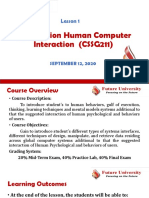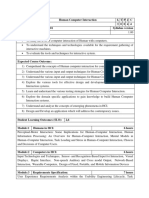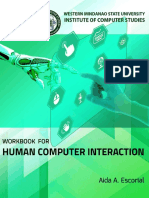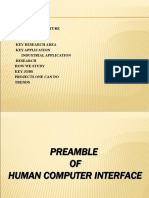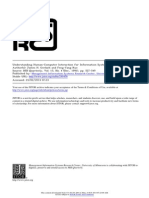CSE4015 Human Computer Interaction L T P J C Pre-Requisite Syllabus Version Course Objectives
CSE4015 Human Computer Interaction L T P J C Pre-Requisite Syllabus Version Course Objectives
Uploaded by
Sankar AyachitulaCopyright:
Available Formats
CSE4015 Human Computer Interaction L T P J C Pre-Requisite Syllabus Version Course Objectives
CSE4015 Human Computer Interaction L T P J C Pre-Requisite Syllabus Version Course Objectives
Uploaded by
Sankar AyachitulaOriginal Title
Copyright
Available Formats
Share this document
Did you find this document useful?
Is this content inappropriate?
Copyright:
Available Formats
CSE4015 Human Computer Interaction L T P J C Pre-Requisite Syllabus Version Course Objectives
CSE4015 Human Computer Interaction L T P J C Pre-Requisite Syllabus Version Course Objectives
Uploaded by
Sankar AyachitulaCopyright:
Available Formats
CSE4015 HUMAN COMPUTER INTERACTION L T P J C
3 0 0 4 4
Pre-requisite ITE1014 Syllabus version
v. 1.0
Course Objectives:
1. To provide the basic knowledge on the levels of interaction, design models, techniques and
validations focusing on the different aspects of human-computer interface and interactions
2. To make the learners to think in design perspective and to evaluate interactive design
3. To use the concepts and principles of HCI to analyze and propose solution for real life
applications
4. To become familiar with recent technology trends and challenges in HCI domain
Expected Course Outcome:
1. Enumerate the basic concepts of human, computer interactions
2. Create the processes of human computer interaction life cycle
3. Analyze and design the various interaction design models
4. Apply the interface design standards/guidelines for evaluating the developed interactions
5. Establish the different levels of communication across the application stakeholders
6. Apply product usability evaluations and testing methods
7. Demonstrate the principles of human computer interactions through the prototype
modelling
Student Learning Outcomes (SLO): 5, 8, 17
Module:1 HCI FOUNDATIONS 6 hours
Input–output channels, Human memory, Thinking: reasoning and problem solving, Emotion, Individual
differences, Psychology and the design of interactive systems, Text entry devices, Positioning, pointing
and drawing, Display devices, Devices for virtual reality and 3D interaction, Physical controls, sensors and
special devices, Paper: printing and scanning
Module:2 DESIGNING INTERACTION 6 hours
Overview of Interaction Design Models, Discovery - Framework, Collection - Observation, Elicitation,
Interpretation - Task Analysis, Storyboarding, Use Cases, Primary Stakeholder Profiles, Project
Management Document
Module:3 INTERACTION DESIGN MODELS 8 hours
Model Human Processor - Working Memory, Long-Term Memory, Processor Timing, Keyboard Level
Model - Operators, Encoding Methods, Heuristics for M Operator Placement, What the Keyboard Level
Model Does Not Model, Application of the Keyboard Level Model, GOMS - CMN-GOMS Analysis,
Modeling Structure, State Transition Networks - Three-State Model, Glimpse Model, Physical Models,
Fitts’ Law
Module:4 GUIDE LINES IN HCI 6 hours
Shneideman's eight golden rules, Norman's Sever principles, Norman's model of interaction, Nielsen's ten
heuristics, Heuristic evaluation, contextual evaluation, Cognitive walk-through
Module:5 COLLABORATION AND COMMUNICATION 5 hours
Face-to-face Communication, Conversation, Text-based Communication, Group working, Dialog design
notations, Diagrammatic notations, Textual dialog notations, Dialog semantics, Dialog analysis and design
Module:6 HUMAN FACTORS AND SECURITY 6 hours
Groupware, Meeting and decision support systems, Shared applications and artifacts, Frameworks for
groupware Implementing synchronous groupware, Mixed, Augmented and Virtual Reality
Module:7 VALIDATION AND ADVANCED CONCEPTS 6 hours
Validations - Usability testing, Interface Testing, User Acceptance Testing
Past and future of HCI: the past, present and future, perceptual interfaces, context-awareness and
perception
Module:8 RECENT TRENDS 2 hours
Total Lecture hours: 45 hours
Text Book(s)
1. A Dix, Janet Finlay, G D Abowd, R Beale., Human-Computer Interaction, 3rd Edition, Pearson
Publishers,2008
Reference Books
1. Shneiderman, Plaisant, Cohen and Jacobs, Designing the User Interface: Strategies for Effective
Human Computer Interaction, 5th Edition, Pearson Publishers, 2010.
2 Hans-Jorg Bullinger,” Human-Computer Interaction”, Lawrence Erlbaum Associates, Publishers
3 Jakob Nielsen,” Advances in Human-computer Interaction”,Ablex Publishing Corporation
4 Thomas S. Huang,” Real-Time Vision for Human-Computer Interaction”, Springer
5 Preece et al, Human-Computer Interaction, Addison-Wesley, 1994
Mode of Evaluation: CAT / Assignment / Quiz / FAT / Project / Seminar
Recommended by Board of Studies 04-04-2014
Approved by Academic Council No. 37 Date 16-06-2015
You might also like
- TTL 2 Midterm ExamDocument5 pagesTTL 2 Midterm Examimee corro100% (6)
- Jennifer Preece - Interaction Design PDFDocument40 pagesJennifer Preece - Interaction Design PDFanon_155279114No ratings yet
- Case StudyDocument4 pagesCase StudyduleekaNo ratings yet
- Lesson 1 Introduction To HCIDocument30 pagesLesson 1 Introduction To HCIJennifer ContrerasNo ratings yet
- Syllabus PDFDocument2 pagesSyllabus PDFDurgavajjala KarthikNo ratings yet
- HCI SyllabusDocument2 pagesHCI Syllabuschaudharisumit325No ratings yet
- Human Computer InteractionDocument2 pagesHuman Computer InteractionChetana ReddyNo ratings yet
- Course Overview and OutlineDocument6 pagesCourse Overview and Outlinegeraldowusuansah2No ratings yet
- Cousre Summary Kk44503 Human Computer Interaction2016 (Asal)Document7 pagesCousre Summary Kk44503 Human Computer Interaction2016 (Asal)AsnietaNo ratings yet
- HCI Course Outline-DSE-UoGDocument2 pagesHCI Course Outline-DSE-UoGAFEEFA ZIANo ratings yet
- Course Outline - HCI - Fall 2020Document6 pagesCourse Outline - HCI - Fall 2020M. Talha NadeemNo ratings yet
- syllabusDocument5 pagessyllabusmohanbabuv14No ratings yet
- Csi1005 User Interface DesignDocument2 pagesCsi1005 User Interface DesignDevendhiran DasarathanNo ratings yet
- HCC SyllabusDocument2 pagesHCC SyllabusSwetha TNo ratings yet
- Course Description:: 3 Hours, Divided Into Two Hours of Lecture and Three Hours For LabDocument1 pageCourse Description:: 3 Hours, Divided Into Two Hours of Lecture and Three Hours For Labسام الفقيهNo ratings yet
- Introduction Ch. 1Document71 pagesIntroduction Ch. 1techworld93100% (2)
- CS 6362: Interactive Systems Spring, 2009: WWW - Cs.utpa - Edu/ Rfowler/csci6362Document5 pagesCS 6362: Interactive Systems Spring, 2009: WWW - Cs.utpa - Edu/ Rfowler/csci6362Karthik RamNo ratings yet
- Hmi Syllabus PDFDocument4 pagesHmi Syllabus PDFTanmay PurandareNo ratings yet
- HCI Notes - Unit 4Document9 pagesHCI Notes - Unit 421211a0574No ratings yet
- Lesson 1- HCI General ConceptsDocument3 pagesLesson 1- HCI General Conceptsbrianndesa262No ratings yet
- R18 B.Tech. CSE Syllabus Jntu HyderabadDocument2 pagesR18 B.Tech. CSE Syllabus Jntu HyderabadOmkar AutadeNo ratings yet
- IM211 Human Computer InteractionDocument4 pagesIM211 Human Computer InteractionLasalle Bosco100% (2)
- Human Computer InteractionDocument38 pagesHuman Computer InteractionPurushothama ReddyNo ratings yet
- KCAU - Distance Learning - HCI ModuleDocument129 pagesKCAU - Distance Learning - HCI ModuleAlvo KamauNo ratings yet
- HCIDocument2 pagesHCIlove1990jainNo ratings yet
- Course Outline Template 2019+ Hci Abid RafiqDocument3 pagesCourse Outline Template 2019+ Hci Abid RafiqSammarNo ratings yet
- Bule Hora University Department of Information TechnologyDocument5 pagesBule Hora University Department of Information TechnologyAschenakiNo ratings yet
- Human Computer Interaction AbstractDocument4 pagesHuman Computer Interaction AbstractRukmini VegesnaNo ratings yet
- Hci Theory SyllabusDocument2 pagesHci Theory SyllabusPreeti Singh100% (1)
- Human Computer Interaction 1Document85 pagesHuman Computer Interaction 1Zcsalweemnharr Bandahala100% (1)
- HCI Notes - Unit 1Document15 pagesHCI Notes - Unit 1knbhavyasreebhavyasreeNo ratings yet
- HCI Lecture 1Document30 pagesHCI Lecture 1Azee AskingNo ratings yet
- ICS IM - Workbook of Aida Escorial For Human Computer InteractionDocument84 pagesICS IM - Workbook of Aida Escorial For Human Computer InteractionZcsalweemnharr BandahalaNo ratings yet
- Human Computer Interaction (Ui & Ux)Document2 pagesHuman Computer Interaction (Ui & Ux)CH SAI KIRAN REDDYNo ratings yet
- HCI Notes - Introdn + UI Design + InteractionDocument13 pagesHCI Notes - Introdn + UI Design + InteractionDaisy RonoNo ratings yet
- A_Review_Paper_on_Human_Computer_InteractionDocument4 pagesA_Review_Paper_on_Human_Computer_InteractionSakshamNo ratings yet
- HCI Notes - Unit 5Document7 pagesHCI Notes - Unit 5MadhukarNo ratings yet
- Hci QBDocument52 pagesHci QBJayaprasannaNo ratings yet
- Human Computer Interaction ConceptsDocument7 pagesHuman Computer Interaction ConceptsintelcorporationNo ratings yet
- ChatGPT For Learning HCI Techniques - A Case Study On Interviews For PersonasDocument16 pagesChatGPT For Learning HCI Techniques - A Case Study On Interviews For PersonasjerryhollywhitebinusNo ratings yet
- The Most Important Findings On Human-Computer Interaction (HCI)Document4 pagesThe Most Important Findings On Human-Computer Interaction (HCI)International Journal of Innovative Science and Research TechnologyNo ratings yet
- (2nd Year) Hci101Document14 pages(2nd Year) Hci101Joseph LapsoNo ratings yet
- Mulungushi University: ICT 462 Human Computer InteractionDocument10 pagesMulungushi University: ICT 462 Human Computer InteractionSean MasuwaNo ratings yet
- Human Computer Interaction RevisionDocument6 pagesHuman Computer Interaction RevisionYoga Adwitya Affan PradanaNo ratings yet
- Human Machine InteractionDocument4 pagesHuman Machine Interactionrsingh19870% (1)
- HCI Course Outlines SEDocument3 pagesHCI Course Outlines SEZubair AhmedNo ratings yet
- Chapter 1 - I: NtroductionDocument44 pagesChapter 1 - I: NtroductionBaraa AbeadNo ratings yet
- Preamble PPT Eit401wt.080310Document26 pagesPreamble PPT Eit401wt.080310Nidhi2408No ratings yet
- HciDocument16 pagesHcivenkateshmukharjiNo ratings yet
- Human Conputer Interaction by DR D Koteshwar RaoDocument149 pagesHuman Conputer Interaction by DR D Koteshwar Raohb4324783No ratings yet
- CSC 112ExamNote713Document38 pagesCSC 112ExamNote713shepherdbakpetNo ratings yet
- Lab Manual HCILDocument51 pagesLab Manual HCILpushpakbharambe4No ratings yet
- Human Computer InteractionDocument20 pagesHuman Computer InteractionBalaji MoturuNo ratings yet
- Chapter 1 Human-Computer Interaction NoteDocument41 pagesChapter 1 Human-Computer Interaction NoteMaliihah NurNo ratings yet
- (2nd Year) Hci101Document26 pages(2nd Year) Hci101ӄɨռɢ• JoshuaNo ratings yet
- PART-1 INTRODUCTION Chapter 123 PDFDocument69 pagesPART-1 INTRODUCTION Chapter 123 PDFعلي بن آل ابراهيم عسيريNo ratings yet
- HCI Lecture Module 1Document7 pagesHCI Lecture Module 1Junny Manglib0% (1)
- Course Title: Human Computer Interaction: Course Code: CMP-3711 Course Structure: Lectures: 3/labs: 0Document2 pagesCourse Title: Human Computer Interaction: Course Code: CMP-3711 Course Structure: Lectures: 3/labs: 0Sumaira NoorNo ratings yet
- 6 - Testing and EvaluationDocument32 pages6 - Testing and Evaluationharis bhuttaNo ratings yet
- Understanding HCI For ISD PDFDocument24 pagesUnderstanding HCI For ISD PDFyousafinamNo ratings yet
- Digital Assignment-1 Name: Ayachitula Sankar Sudheer Reg No: 18BCE0556Document6 pagesDigital Assignment-1 Name: Ayachitula Sankar Sudheer Reg No: 18BCE0556Sankar AyachitulaNo ratings yet
- Digital Assignment-1 Name: Ayachitula Sankar Sudheer Reg No: 18BCE0556Document6 pagesDigital Assignment-1 Name: Ayachitula Sankar Sudheer Reg No: 18BCE0556Sankar AyachitulaNo ratings yet
- Digital Assignment 2Document16 pagesDigital Assignment 2Sankar AyachitulaNo ratings yet
- PDC Review 1Document6 pagesPDC Review 1Sankar AyachitulaNo ratings yet
- PDC Review 1Document6 pagesPDC Review 1Sankar AyachitulaNo ratings yet
- Decision Making ProcessDocument2 pagesDecision Making Processjoel konseNo ratings yet
- Divine Word College of Laoag Requirement FormatDocument5 pagesDivine Word College of Laoag Requirement FormatCaparispisan PagudpudNo ratings yet
- UG 24 25 FeesDocument5 pagesUG 24 25 Feesdrugiekonto967No ratings yet
- W1-2 - Ipt PR2, Eapp & FSPLDocument4 pagesW1-2 - Ipt PR2, Eapp & FSPLAshanti JavierNo ratings yet
- Activity Sheet 10.1 Lesson Plan Template - 5E ModelDocument4 pagesActivity Sheet 10.1 Lesson Plan Template - 5E ModelNasyirin FadilahNo ratings yet
- 2024 DFOT Guidelines For SCIENCE StemazingDocument3 pages2024 DFOT Guidelines For SCIENCE Stemazingmenmic749100% (1)
- BasicelementsandcharacteristicsofmobilelearningDocument7 pagesBasicelementsandcharacteristicsofmobilelearningChristanne ArbadoNo ratings yet
- BT FinalDocument28 pagesBT Finalzala ujjwalNo ratings yet
- Elements or Components of A Curriculum DesignDocument5 pagesElements or Components of A Curriculum DesignErrol CatimpoNo ratings yet
- Math 1 SyllabusDocument17 pagesMath 1 SyllabusCyrylle Doyayag MagloyuanNo ratings yet
- Discussion: Read and Understand: Lesson 1: Research and InquiryDocument3 pagesDiscussion: Read and Understand: Lesson 1: Research and InquiryKimberly Hosmillo ImperialNo ratings yet
- DLL Alma PandiwaDocument3 pagesDLL Alma PandiwaCharmagne BorraNo ratings yet
- Research Designs - SolaDocument26 pagesResearch Designs - SolaJasmine SeunNo ratings yet
- General Administrative TheoryDocument10 pagesGeneral Administrative TheoryZunaira Tauqeer50% (2)
- Giz SBC Pratitioners Guide WebDocument48 pagesGiz SBC Pratitioners Guide WebNhatminh DaylightNo ratings yet
- Self-Questioning Strategy Training: Voices From Students in IndonesiaDocument5 pagesSelf-Questioning Strategy Training: Voices From Students in IndonesiaNur Azizah RahmanNo ratings yet
- LESSON 3 - I AM A DEVELOPING TEENAGER - PPTMDocument16 pagesLESSON 3 - I AM A DEVELOPING TEENAGER - PPTMJoy AlquizarNo ratings yet
- Piaget'S Theory of Cognitive DevelopmentDocument5 pagesPiaget'S Theory of Cognitive DevelopmentHadassah Joy EginoNo ratings yet
- Lab 3 - Baim Lab Handout - Level 3Document2 pagesLab 3 - Baim Lab Handout - Level 3api-477617112No ratings yet
- The Importance Wps Office 2Document10 pagesThe Importance Wps Office 2CHIELO PASTRANANo ratings yet
- Cobit201934353 137645 1 PBDocument9 pagesCobit201934353 137645 1 PBCaptain SkyNo ratings yet
- Lec#1intro Health and WellnessDocument2 pagesLec#1intro Health and WellnessFatima 1214No ratings yet
- Lesson 1Document35 pagesLesson 1clement lesibaNo ratings yet
- Chap001 130427225322 Phpapp01Document21 pagesChap001 130427225322 Phpapp01Antoine RahalNo ratings yet
- Identity in Adolescence The Balance Between Self and Other Adolescence and Society 3rd Edition Jane KrogerDocument84 pagesIdentity in Adolescence The Balance Between Self and Other Adolescence and Society 3rd Edition Jane Krogerlslhawaj27No ratings yet
- Pengaruh Product Knowledge Terhadap Purchase Intention (Survei Pada Pengunjung Toko Buku UB Press, Kota Malang)Document7 pagesPengaruh Product Knowledge Terhadap Purchase Intention (Survei Pada Pengunjung Toko Buku UB Press, Kota Malang)JojoNo ratings yet
- OBE Awareness Seminar (16.6.21) - Engr. Asim AbbasDocument36 pagesOBE Awareness Seminar (16.6.21) - Engr. Asim AbbasAltaf Hussain 17BNCIV0950No ratings yet
- BSBPEF402 Presation Slides v1.0Document53 pagesBSBPEF402 Presation Slides v1.0EwriterNo ratings yet



